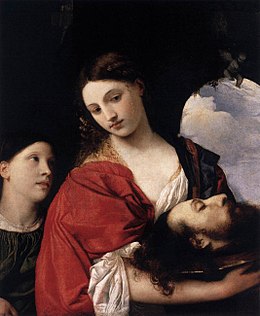| Salome | |
|---|---|
 | |
| Artist | Titian |
| Year | c. 1515 |
| Medium | Oil on canvas |
| Dimensions | 90 cm × 72 cm (35 in × 28 in) |
| Location | Doria Pamphilj Gallery, Rome |
Salome, or possibly Judith with the Head of Holofernes, is an oil painting which is an early work by the Venetian painter of the late Renaissance, Titian. It is usually thought to represent Salome with the head of John the Baptist. It is usually dated to around 1515 and is now in the Doria Pamphilj Gallery in Rome. Like other paintings of this subject,[1] it has sometimes been considered to represent Judith with the head of Holofernes, the other biblical incident found in art showing a female and a severed male head.[2] Historically, the main figure has also been called Herodias, the mother of Salome.
Sometimes attributed to Giorgione, the painting is now usually seen as one where Titian's personal style can be seen in development, with a "sense of physical proximity and involvement of the viewer", in which "expert handling of the malleable oil medium enabled the artist to evoke the sensation of softly spun hair upon creamy flesh".[3]
Erwin Panofsky suggested the head of John the Baptist might be a self-portrait,[4] and it is possible that Titian was alluding to his private life with the model, anticipating Cristofano Allori's, Judith with the Head of Holofernes (1613, Royal Collection, and other versions), where the severed head was a self-portrait and Judith and the maid portraits of his ex-mistress and her mother.[5] The model here, allowing for a degree of idealization, has been said to be the same used in the Dresden Venus (Giorgione and Titian, c. 1510) and Venus and Cupid (c. 1510–1515).[6] It has been said that around this time depictions of Salome moved from a passive to a more seductive figure.[7]
This composition was copied many times, in at least some cases by Titian's workshop.[8]
- ^ Ciletti, 50
- ^ DP. Safarik's official guide of 1993 calls it "Judith with the Head of Holofernes (known as Salome)", but in 2022 the museum website called it Salome. See below also.
- ^ Jaffé, 72
- ^ Robertson, 220; Hale, 147; Neginsky, 96 quotes him, 98–99; Falomir
- ^ Neginsky, 96
- ^ Hale, 147; Robertson, 219
- ^ Dunkelman, Martha Levine (April 1999). "The Innocent Salome". Gazette des Beaux-Arts. 133 (1563): 173–80.
- ^ Norton; Robertson, 219